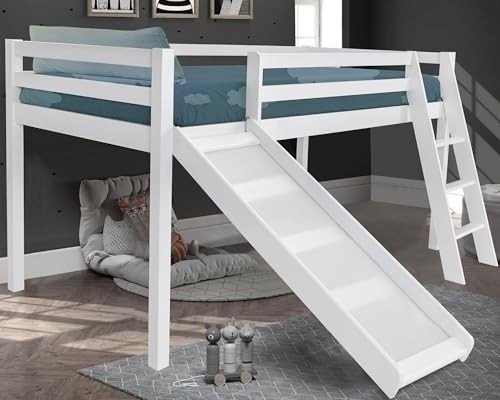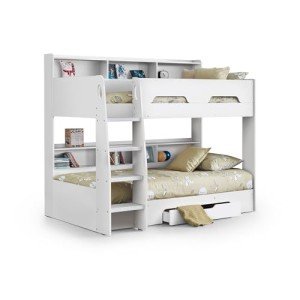
Exploring Bunk Beds: A Comprehensive Guide
Bunk beds have long been a staple in kids's bed rooms, dormitories, and even homes with restricted space. Not only do they offer a useful sleeping option, but they likewise produce an enjoyable and imaginative environment for kids and a great space-saver for adults and families. This short article will explore whatever you require to understand about bunk beds, from types and materials to safety suggestions and purchasing suggestions.
Tabulation
- Kinds Of Bunk Beds
- Conventional Bunk Beds
- Loft Beds
- Triple uk bunk beds Beds
- L-Shaped Bunk Beds
- Product Options
- Wood
- Metal
- Safety Considerations
- Purchasing Guide
- Frequently asked questions
Kinds Of Bunk Beds
Bunk beds can be found in numerous styles to match various needs and choices. Here's a breakdown of the most typical types:
Conventional Bunk Beds
Standard bunks usually feature two beds stacked vertically on top of one another. These beds are ideal for siblings sharing a space or for making the most of sleeping space in visitor spaces.
Loft Beds
Loft beds stand similarly to conventional bunk beds but do not have a lower sleeping area. Instead, they often incorporate a desk or seating area underneath, making them a great choice for little rooms requiring multifunctionality.
Triple Bunk Beds
Triple bunk beds are developed for 3 occupants, with beds stacked in a three-tier configuration. These are less typical however can be a fun solution for large households or slumber parties.

L-Shaped Bunk Beds
With one bed placed horizontally and the other vertically, L-shaped bunk beds are frequently geared up with additional functions such as desks or storage drawers and can match corner spaces in a room.
Contrast of Bunk Bed Types
| Bed Type | Perfect Use | Description |
|---|---|---|
| Standard | Shared bed rooms or visitor spaces | Two beds stacked vertically |
| Loft | Small rooms needing multi-purpose space | Upper bed with open space below |
| Triple | Big families or pajama parties | 3 beds stacked vertically |
| L-Shaped | Corner or flexible spaces | A mix of vertical and horizontal beds |
Product Options
Bunk beds are produced from different products, with wood and metal being the most common. Each product has its benefits and drawbacks.
Wood
- Durability: Generally robust and can hold up against years of use.
- Aesthetic Appeal: Offers a traditional appearance that can blend with different decors.
- Weight Capacity: Typically tougher; can support heavier weights.
- Downsides: May be more costly than metal choices and can be vulnerable to scratches.
Metal
- Strength: Generally light-weight and easy to move however still sturdy.
- Modern Design: Often is available in sleek designs, making it appealing for modern areas.
- Cost-efficient: Usually less expensive than wooden choices.
- Disadvantages: Can be cold to the touch in winters and might not have the same aesthetic appeal for some purchasers.
Security Considerations
When it concerns bunk beds, security can not be overlooked. Here are key safety suggestions to keep in mind:
- Guardrails: Ensure that the top bunk has guardrails on both sides to avoid falls.
- Strong Construction: Check for a strong build and sturdy materials to hold up against weight and movement.
- Weight Limit: Adhere to the producer's weight limit for both the upper and lower bunks.
- Ladder Design: Choose bunks with a safe, easy-to-climb ladder and prevent any sharp edges or rungs.
- Age Restrictions: Most manufacturers advise that children under the age of 6 ought to not sleep in the upper bunk.
Buying Guide
When searching for bunk beds, consider the list below factors to find the very best bunk bed fit for your requirements:
- Space saving Bunk Beds Availability: Measure the space size and ceiling height, making sure there is sufficient space for the top bunk.
- Bed Size: Decide in between twin, complete, or bigger sizes based on your requirements and the size of the space.
- Style Preference: Consider the general design of the bed room to find an ideal style.
- Relieve of Setup: Look for a bunk bed that is straightforward to assemble.
- Budget plan: Bunk beds are available in numerous price varieties, so identify a budget plan before beginning your search.
FAQs
1. What is the advised age for kids to sleep on the top bunk?
Kids aged six and older are generally advised to sleep on the leading bunk beds for teens to minimize the risk of falls.
2. How can I make my bunk bed safer?
To enhance security, ensure guardrails are effectively installed and check that the bed is put on a flat surface area. Furthermore, encourage children to utilize the ladder carefully.
3. Can I convert a bunk bed into two separate beds?
Lots of bunk beds are developed to be convertible. Check the manufacturer's requirements for convertibility functions.
4. What accessories are available for bunk beds?
Typical accessories consist of bed linens, storage drawers, staircases rather of ladders, and tented canopies for an enjoyable visual appeal.
5. How do I maintain my bunk bed?
Routine look for loose screws or structural integrity can help make sure safety. Dust the bed frequently and tidy spills without delay to keep the products in good condition.
Bunk beds are versatile and a space-efficient option for different living scenarios, from kids's spaces to visitor accommodations. With lots of designs and products available, potential buyers have a wealth of options to think about, making sure a mix of functionality and aesthetics. By prioritizing safety and following the tips laid out in this guide, individuals can find the ideal bunk bed that matches their space and lifestyle, all while producing an enjoyable sleeping environment.
